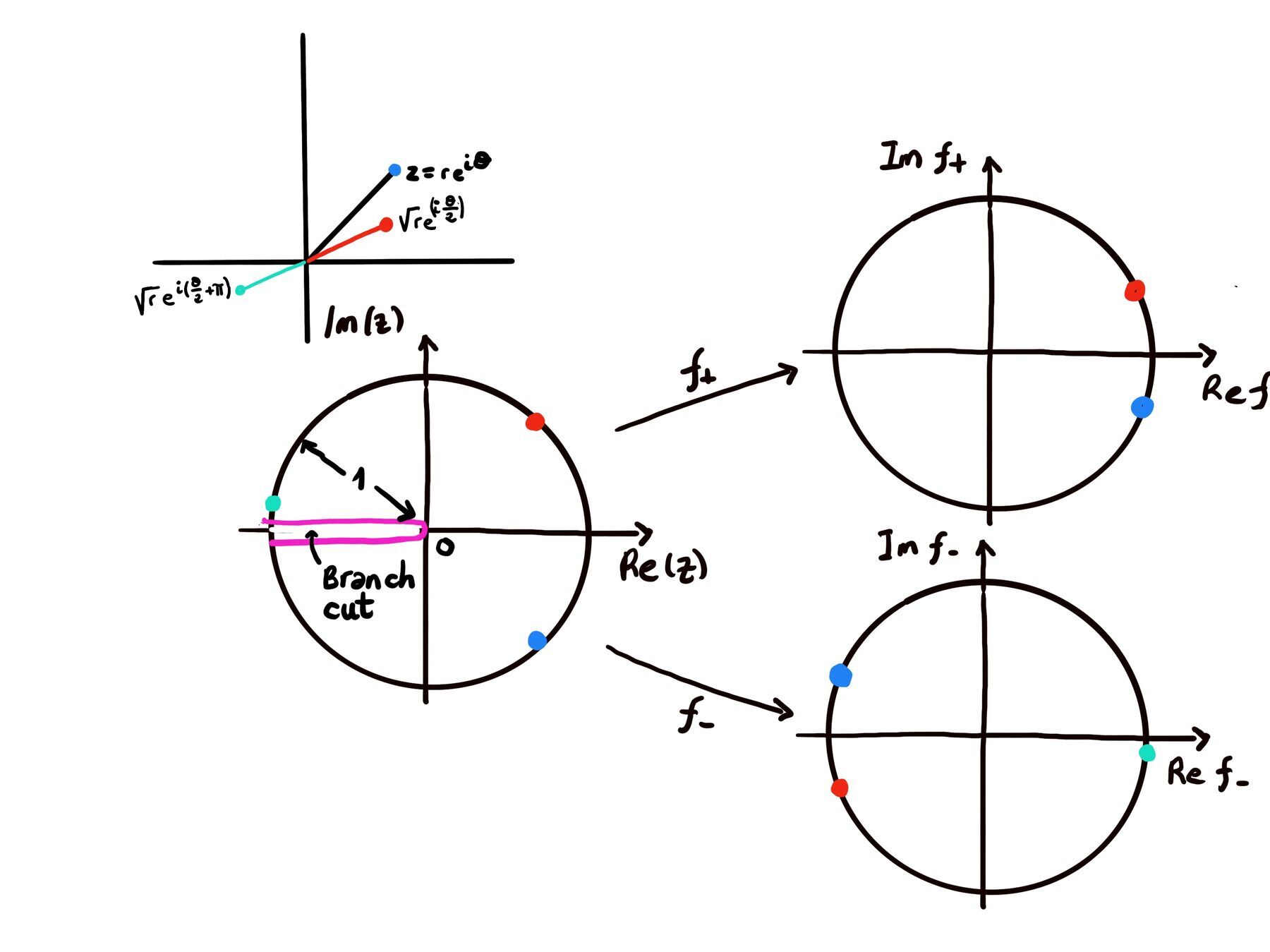
|
 |
 |
Assumption is the mother of all screw-ups, Anonymous.

The square root function is a fundamental mathematical function with wide-ranging applications in mathematics, science, and engineering. It is written as: f(x) = $\sqrt{x}$.
It gives the non-negative number that, when multiplied by itself, equal the input x. For example, $\sqrt{16}$ = 4 because 4 × 4 = 16, $\sqrt{49}$ = 47 because 7 × 7 = 49, $\sqrt{64}$ = 8 because 8 × 8 = 64.
A complex number is expressed as $ z = a + bi $, where $ a $ and $ b $ are real numbers, and $ i $ is the imaginary unit ($ i^2 = -1 $). The square root of a complex number $ z $ is a number $ w $ such that $ w^2 = z $. Unlike real numbers, every non-zero complex number has exactly two distinct square roots (and 0 has the unique root 0).
The most straightforward method to compute complex square roots uses polar form. For any nonzero complex number z, we can write it as $z = re^{i\theta}$ where:
Then the square roots are obtained by halving the modulus and the argument.
For instance, the square roots of $−1=e^{\pi}$ are i = $e^{\pi/2}$ and −i = $e^{3\pi/2}$.
Since angles in polar form are periodic ($ \theta \equiv \theta + 2\pi $), halving $ \theta $ gives two distinct roots separated by $ \pi $ radians — exactly half a full rotation — which places them on opposite sides of the origin in the complex plane.
In other words, the modulus of the root is the square root of the original modulus. The angle of the root is half the original angle. The second root lies diametrically opposite the first root (separated by $\pi$ radians).
If z = a + bi with z ≠ 0, assume the square roots of z to be w = u + iv, that is $\sqrt{a + bi} = u + iv$
Now, squaring both side of the equation, we have: $a + bi = u^2 -v^2 + 2iuv$. Comparing real and imaginary parts of the above equation, we have: $a = u^2 -v^2, b = 2uv$
We know that $(u^2 + v^2)^2 = (u^2 - v^2)^2 + 4u^2v^2 = a^2 + b^2 \leadsto u^2 + v^2 = \sqrt{a^2 + b^2 }$ because u² + v² is always positive as sum of squares of non-zero real numbers is always greater than zero.
Now, we have $u^2 + v^2 = \sqrt{a^2 + b^2 }$ and $a = u^2 -v^2$. Solving for these two values, we have $2u^2-a = \sqrt{a^2 + b^2} \leadsto u^2 = \frac{|z|+a}{2}, v^2 = u^2 - a = \frac{|z|+a}{2} -a = \frac{|z|-a}{2}$
Since 2uv = b, we have: (1) u and v have the same sign if b > 0 or (2) u and v have opposite signs if b < 0.
Therefore the square root of complex number a + ib (b ≠ 0) is given by $u = \sqrt{\frac{|z|+a}{2}}, v = sgn(b)\sqrt{\frac{|z|-a}{2}}, \sqrt{a + ib} = \plusmn \sqrt{\sqrt{\frac{|z|+a}{2}}+(\frac{ib}{|b|})\sqrt{\frac{|z|-a}{2}}}$
Example:
Unlike real numbers, every non-zero complex number has exactly two distinct square roots. The challenge is defining a consistent function, $\sqrt{z}$, that selects one of these two values.
Now, let’s take the square root: $z^{1/2} = \sqrt{r} \cdot e^{i\theta/2}$. Recall that the argument θ is not unique. It is indeed multivalued. You can add any multiple of 2π and still represent the same complex number: $z = re^{i(\theta + 2\pi n)} \text{ for any integer } n$
So when we take the square root: $z^{1/2} = \sqrt{r} \cdot e^{i(\theta + 2\pi n)/2} = \sqrt{r} \cdot e^{i\theta/2} \cdot e^{i\pi n}$. Since $e^{i\pi n} = (-1)^n$, we get two distinct values: $\sqrt{r} \cdot e^{i\theta/2}, -\sqrt{r} \cdot e^{i\theta/2} = \sqrt{r} \cdot e^{i\theta/2+i\pi}$
A branch cut is a curve (or line) in the complex plane that we agree not to cross. Those two previous values correspond to the two branches of the square root function:

Conclusion: These branches are distinct because the square root function is not single-valued over the complex plane. To make it single-valued, we define a branch cut, typically along the negative real axis, and restrict the argument θ to a specific interval. A key feature of the principal root is that its real part is always non-negative. f+(z) maps the entire complex plane (minus the branch cut) to the right half-plane. Similarly, f-(z) lies in the left half-plane, including the negative real axis.
Each branch $f^+$ or $f^-$ is holomorphic (complex-differentiable) on its domain $\mathbb{C}\setminus(-\infty,0]$. Across the cut itself, neither branch extends continuously.
Monodromy (sheet switching). Analytically continuing $\sqrt{z}$ once around a loop encircling 0 flips the sign (you move to the other sheet). Two loops bring you back.
For example, on the principal branch: $f_+(z)^2 = z$.
Differentiating both sides: $2·f_+(z)·f_+^{'}(z) = 1 \leadsto f_+^{'}(z) = \frac{1}{2·f_+(z)} = \frac{1}{2\sqrt{z}}$ valid on ℂ \ (-∞, 0} (and z ≠ 0).
A more fundamental way to define the square root is via the complex exponential and logarithm functions: $z^{1/2} = e^{\frac{1}{2}log(z)}$
The multi-valued nature of the square root comes directly from the multi-valued nature of the logarithm: log(z) = ln(r) + i(θ + 2πk).
Substituting this into the formula gives: $z^{1/2} = e^{\frac{1}{2}log(z)} = e^{\frac{1}{2} \left( \ln r + i(\theta + 2\pi k) \right)} = \sqrt{r}·e^{i\frac{\theta + 2\pi k}{2}} = \sqrt{r}·e^{i\frac{\theta}{2}}·e^{i\pi k} = \sqrt{r}·e^{i\frac{\theta}{2}}·(-1)^k$.
This shows that an even k (like k = 0, 2,…) results in one root ($e^{i\pi k} = 1$), while an odd k (like k=1,3,…) results in the other ($e^{i\pi k} = - 1$). Choosing the principal branch of the logarithm corresponds to choosing the principal branch of the square root.
The core issue is that the complex logarithm, log(z), is a multi-valued function. For any complex number $z = re^{i\theta}$, its logarithm is log(z) = ln(r) + i(θ + 2πk) where k can be any integer (k ∈ ℤ). Each value of k produces a different value for the logarithm.
When we define $z^α := e^{α·log(z)}$. We define an analytic branch of $z^α$ by choosing a branch of Log(z), this multi-valuedness carries over: $z^α = e^{α·(ln(r) + i(θ + 2πk))} = e^{α·(ln(r) + iθ)}e^{α·i2πk}$
Let’s analyze the two parts of this product:
The number of distinct values depends on α:
To create a proper, single-valued, and analytic (differentiable) function from $z^α$, we must make a consistent choice. By choosing a branch for log(z), we are essentially fixing the value of k (usually k = 0) and restricting the domain of the argument θ. The principal branch of zᵅ is defined by using the principal branch of the logarithm, Log(z) = ln∣z∣ + iArg(z), where Arg(z) ∈ (−π, π].
This gives the principal Value of $z^α$: $z^α = e^{α·Log(z)}$ where Arg(z) is the principal argument in (−π,π]. A key feature of the principal root is that its real part is always non-negative. It maps the entire complex plane (minus the branch cut) to the right half-plane.
Example:
The full-multivalued set is iⁱ = {$e^{-\frac{\pi}{2}}·e^{i·i2πk} = e^{-\frac{\pi}{2}-2πk} | k \in \mathbb{Z}$}
The full-multivalued set is (-1)ⁱ = {$e^{-\pi}·e^{i·i2πk} = e^{-(\pi + 2\pi k)} = e^{-(\pi + 2\pi k)} = e^{-(2k+1)\pi} | k \in \mathbb{Z}$}